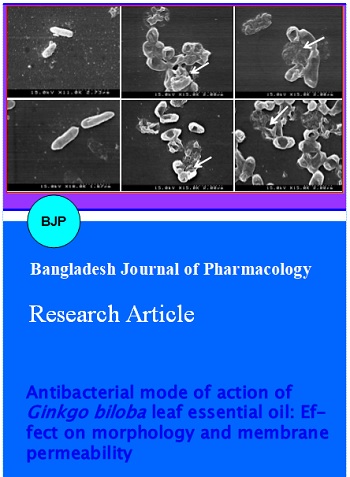Antibacterial mode of action of Ginkgo biloba leaf essential oil: Effect on morphology and membrane permeability
DOI:
https://doi.org/10.3329/bjp.v10i2.22546Keywords:
Antibacterial, Essential oil, Ginkgo biloba, Membrane permeabilityAbstract
This study was aimed to evaluate antimicrobial mode of action of Ginkgo biloba leaf essential oil against foodborne pathogenic bacteria. Gas-chromatography and mass-spectrometric analysis determined 34 different compounds, representing 95.45% of the total oil. The G. biloba leaf essential oil (1,000 µg/disc) showed potential antibacterial effect as diameters of inhibition zones (12.0 ± 0.4-18.0 ± 1.2 mm) along with minimum inhibitory and minimum bactericidal concentration values ranging of 250-1,000 µg/mL. Also the G. biloba leaf essential oil had potential inhibitory effect on the cell viability of the tested pathogens. The scanning electron microscopic analysis using G. biloba leaf essential oil showed considerable morphological alterations on the cell wall of tested pathogens. The oil revealed its mode of action on membrane integrity as confirmed by release of extracellular ATP, increase of 260-nm absorbing materials and increased leakage of potassium ions against foodborne pathogenic bacteria.
Downloads
1111
572 Read
301

Published
How to Cite
Issue
Section
License
Authors who publish with this journal agree to the following terms:
- Authors retain copyright and grant the journal right of first publication with the work simultaneously licensed under a Creative Commons Attribution License that allows others to share the work with an acknowledgement of the work's authorship and initial publication in this journal.
- Authors are able to enter into separate, additional contractual arrangements for the non-exclusive distribution of the journal's published version of the work (e.g., post it to an institutional repository or publish it in a book), with an acknowledgement of its initial publication in this journal.
- Authors are permitted and encouraged to post their work online (e.g., in institutional repositories or on their website) prior to and during the submission process, as it can lead to productive exchanges, as well as earlier and greater citation of published work (See The Effect of Open Access).
